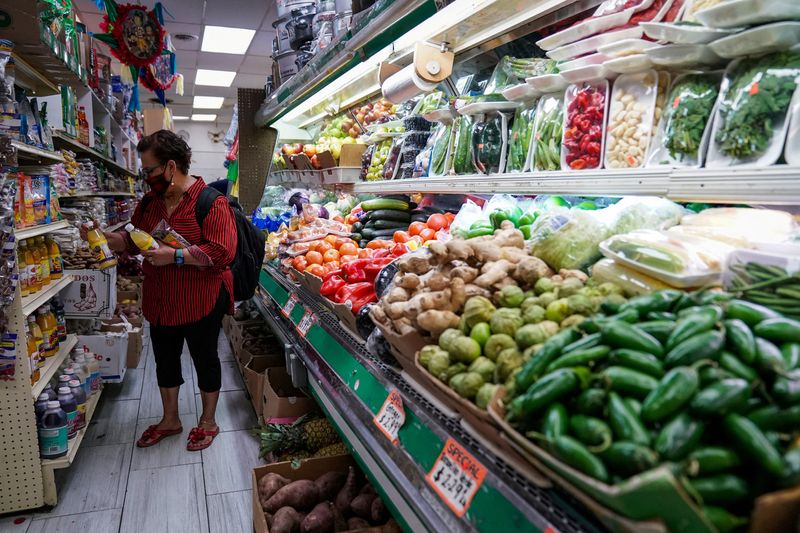By Lucia Mutikani
WASHINGTON (Reuters) - U.S. producer prices increased more than expected in September amid higher costs for energy products and food, but underlying inflation pressures at the factory gate continued to abate.
The mixed report from the Labor Department on Wednesday was published ahead of the release on Thursday of September's consumer price index data, which is expected to show inflation moderated last month. The report is being closely watched for clues on whether the Federal Reserve will raise interest rates against the backdrop of higher U.S. Treasury yields and conflict in the Middle East.
"The Fed has not finished the job and stamped inflation out completely yet, and if anything, policymakers have their work cut out for them as much of the inflation we see in producer prices is coming from food and energy prices that monetary policy has less effect on," said Christopher Rupkey, chief economist at FWDBONDS in New York.
The producer price index for final demand rose 0.5% last month after accelerating by an unrevised 0.7% in August.
Economists polled by Reuters had expected the PPI would gain 0.3%. In the 12 months through September, the PPI increased 2.2% after advancing 2.0% in August.
The narrower measure of PPI, which strips out food, energy and trade services components, gained 0.2% after rising by the same margin in August. The so-called core PPI increased 2.8% on a year-on-year basis in September after climbing 2.9% in August.
Wholesale goods prices increased 0.9%, with a 3.3% rise in the cost of energy products accounting for nearly three-quarters of the increase. Goods prices jumped 2.0% in August.
Gasoline prices rose 5.4%, making up more than 40% of the increase in the cost of goods. There were also increases in the prices of jet fuel, electric power and diesel fuel. Food prices rebounded 0.9%, with processed young chicken and meat costing more. But prices for fresh and dry vegetables declined 13.9%. Wood pulp and utility natural gas prices also decreased.
Excluding the volatile food and energy components, core goods prices edged up 0.1% for the second straight month. This mostly reflected the normalization of supply chains, whose disruption fueled goods inflation in the aftermath of the COVID-19 pandemic.
Though core inflation is cooling, higher gasoline and food prices could hamper progress by raising the cost of other goods as well as causing consumers to expect inflation to rise.
"From the Fed's perspective, cooler goods prices are a necessary, but not sufficient, condition in restoring price stability right now," said Will Compernolle, macro strategist at FHN Financial in New York. "The most concerning consumer inflation is in core services, which has a weaker connection with the PPI, and rising energy prices pose an upside inflation risk via pass-through effects and inflation expectations."
Stocks on Wall Street were mixed. The dollar slipped against a basket of currencies. U.S. Treasury prices rose, with the yield on the benchmark 10-year note pulling back further from 16-year highs following recent dovish remarks from Fed officials and the violence in the Middle East.
SERVICES RISE MODERATELY
Financial markets overwhelmingly anticipate the U.S. central bank will leave rates unchanged at its Oct. 31-Nov. 1 policy meeting, according to CME Group's (NASDAQ:CME) FedWatch Tool
Top ranking Fed officials indicated on Monday that soaring yields on long-term U.S. government bonds could steer the central bank away from further rate hikes. Since March 2022, the Fed has raised its benchmark overnight interest rate by 525 basis points to the current 5.25%-5.50% range.
"This is an important shift, but one perhaps markets are misinterpreting," said Alex McGrath, chief investment officer at NorthEnd Private Wealth in Greenville, South Carolina. "The problem, however, is if bonds rally aggressively from here, does this put a rate hike back firmly on the table?"
The economy continues to forge ahead despite the hefty rate hikes, having created 336,000 jobs in September, the most in eight months and almost double the amount economists had expected in a Reuters survey.
The cost of services increased 0.3% last month, boosted by a 13.9% surge in deposit services, after rising 0.2% in August. Prices for services less trade, transportation, and warehousing increased 0.3%. Trade services, which measure changes in margins received by wholesalers and retailers, climbed 0.5%. But the cost of transportation and warehousing services fell 0.4%.

Hotel and motel accommodation prices rebounded 2.0%. Healthcare costs increased, with the cost of hospital inpatient care rising 0.3% and outpatient care advancing 0.4%. But prices for airline tickets fell 2.1% and portfolio management fees dropped 0.5%. These components go into the calculation of the personal consumption expenditures (PCE) price indexes, the inflation measures tracked by the Fed for its 2% target.
Based on the PPI data, economists estimated that the core PCE price index rose 0.2% in September after edging up 0.1% in August. That would push the annual increase in the core PCE price index to 3.7% in September from 3.9% in August.